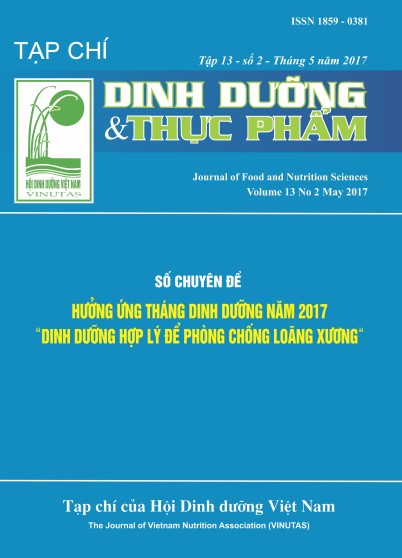ANTHROPOMETRIC AND NUTRITIONAL STATUS IN PUBERTY OF ADOLESCENTS IN SECONDARY SCHOOL OF CU CHI TOWN
Main Article Content
Abstract
Objectives: Studying the anthropometric and nutritional status of adolescents in stages of puberty. Methods: A cross-sectional study on 1280 adolescents enrolled in secondary schools in the town of Cu Chi during the school year 2012-2013. Results: Percentage of overweight-obesity adolescents were 33% (including 22 % obese and 11 % overweight), in which, percentage of overweight-obesity in boys were higher than that of girls (40.7% compared to 25%; p<0.05). Percentage of underweight students was recorded at 4.1% (5.2 % in boys, higher than 2.9 % in girls; p<0.05). Difference of average height between the onset and the end of puberty were 24.1 cm in boys and 16.1cm in girls. Difference of average weight between the onset and the end of puberty were 18.5 kg in boys and 17.7 kg in girls. Average body fat percentage (BFP) of overweight-obesity boys and girls were higher than adolescents with normal nutritional status, but BFP of overweight-obesity ones remained constant at the same level from beginning to the end of pubertal time. There were no differences on the average fat-free mass between different nutritional status groups. Conclusions: At the Cu Chi secondary school, the percentage of overweight-obesity adolescents was higher than that of underweight adolescents, with higher percentage in boys than in girls in both of these malnutrition status groups. Total pubertal height gain was 24.1 cm in boys and 16.1 cm in girls. Puberty did not increase the chances for overweight-obesity in adolescents.
Keywords
Nutritional status, stages of puberty, height, weight, body composition
Article Details
References
2. WHO (2014). Sexual maturity rating (Tanner Staging) in Adolescent. World Health Organization World Health Organization Switzeland.
3. Trần Thị Xuân Ngọc (2012). Thực trạng và hiệu quả can thiệp thừa cân béo phì của mô hình truyền thông giáo dục dinh dưỡng ở trẻ em từ 6-14 tuổi tại Hà Nội. Luận án Tiến sĩ, Viện Dinh Dưỡng Viện Dinh Dưỡng.
4. Trung tâm Dinh Dưỡng TP. Hồ Chí Minh (2015). Số liệu điều tra dinh dưỡng học sinh TPHCM năm 2014. Tình trạng dinh dưỡng trẻ em TPHCM năm 2014, TPHCM, Trung tâm Dinh dưỡng TPHCM.
5. Ruveyde Bundak et al (2008). Puberty and Pubertal Growth in Healthy Turkish Girls: No evidence for secular trend. J Clin Res Pediatr Endocrinol., 1 (1), pp. 8-14.
6. Albasi V (1998). Growth and Normal Puberty. Pediatrics, 102 pp. 507-511
7. Tanner JM, Whitehose RH, and Resele LF (1976). The adolescent growth spurt of boys and girls of the Harpenden Growth Study. Annals of Human Biology 3(2), pp. 109-126
8. Tornova A, Kumanov P (2010). Growth and Development of Male Extenal Genitalia. Arch Pediatics Adolescent Medicine, 164 (12), pp. 1151-1157.
9. Mirzaee HS, Mosallanejad A, Rabbani A, et al. (2016). Assessment of Sexual Maturation Among Girls With Special Needs in Tehran, Iran. Iranian Journal of Pediatrics, 26 (5), pp.
10.Stang J, Story M (2012). Chapter 1: Adolescent growth and development. Guidelines for Adolescent Nutrition Service, University of Minesota.
Similar Articles
- Minh Thuy NGUYEN, Nguyễn Duy Tân, Thi Truc Ly NGUYEN, Thu Nhu PHAM, EFFECT OF SODIUM METABISULFITE AND TEMPERATURE TREATMENT ON THE QUALITY OF DRIED CORIANDER (Coriandrum sativum) , Vietnam Journal of Nutrition & Food: Vol. 14 No. 6 (2018)
You may also start an advanced similarity search for this article.


